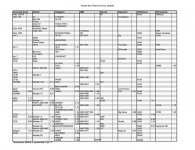There was a post on the Hide when it was on Scout.com regarding change in velocity per degree temperature change.
www.scout.com/military/snipers-hide/forums/5514-bolt-action-rifles/13858015-temp-sensitivity-data-for-most-common-powders-fps-deg?s
I found this mentioned on Accurate Shooter.com
I tried the link and couldn't get it to work. Is anyone aware of an inclusive chart, similar to the powder burn rate charts that are available, that shows the approximate change in velocity due to a degree in temperature for specific powders.. Since I do use some powders that are temperature sensitive, and shoot from 0-75 degrees, it would help me in deciding which old stock to use where.
This was some of the info that was posted in 2015. Do your results mimic this?
Also one poster stated
The rule of thumb I use is:
0.5 fps/degree F for single based powders (like Hodgdons extreme and most stick powders).
1.5 fps/degree F for double based powders (like MAGPRO and most ball powders).
I have several of the powders on the bottom of the chart that I haven't used in quite a while.... but I should use up the odds and ends... at some point.
Reposted in order of smallest to largest variance.
Varget .19 fps per *
H1000 .21 fps per *
H4895 .23 fps per *
H4350 .29 fps per *
H4831 .36 fps per *
Benchmark .44 fps per *
AA4350 .47 fps per *
Retumbo .49 fps per *
Imr4064 .53 fps per *
Imr8208xbr .59 fps per *
Imr4350 .64 fps per *
RL10x .71 fps per*
Imr3031 .73 fps per *
Alliant AR comp .77 fps per *
Hybrid 100v .78 fps per *
Ramshot Hunter .86 fps per *
Imr4895 .87 fps per *
Ramshot Magnum .87 fps per *
Alliant Varmint pro .89 fps per *
Ramshot Tac .91 fps per *
AA2520 .98 fps per *
Ramshot Biggame .98 fps per *
PP2000MR .99 fps per *
Magpro 1.01 fps per *
VV N150 1.08 fps per *
AA4064 1.11 fps per *
Imr4227 1.17fps per *
Imr4831 1.19 fps per *
HS-6 1.21fps per *
H110/W296 1.24 fps per *
VV N160 1.24 fps per *
Lil' Gun 1.31 fps per *
W748 1.32 fps per *
Imr4320 1.32 fps per *
Imr7828 1.36 fps per *
H414/W760 1.42 fps per *
RL17 1.42 fps per *
H380 1.44 fps per *
RL15 1.52 fps per * from 50* and up
RL25 1.59 fps per *
RL19 1.61 fps per *
H50bmg 1.64 fps per *
US869 1.68 fps per *
RL22 1.71 fps per *
Are the numbers above for these powders similar to the results you have experienced?
www.scout.com/military/snipers-hide/forums/5514-bolt-action-rifles/13858015-temp-sensitivity-data-for-most-common-powders-fps-deg?s
I found this mentioned on Accurate Shooter.com
I tried the link and couldn't get it to work. Is anyone aware of an inclusive chart, similar to the powder burn rate charts that are available, that shows the approximate change in velocity due to a degree in temperature for specific powders.. Since I do use some powders that are temperature sensitive, and shoot from 0-75 degrees, it would help me in deciding which old stock to use where.
This was some of the info that was posted in 2015. Do your results mimic this?
Also one poster stated
The rule of thumb I use is:
0.5 fps/degree F for single based powders (like Hodgdons extreme and most stick powders).
1.5 fps/degree F for double based powders (like MAGPRO and most ball powders).
I have several of the powders on the bottom of the chart that I haven't used in quite a while.... but I should use up the odds and ends... at some point.
Reposted in order of smallest to largest variance.
Varget .19 fps per *
H1000 .21 fps per *
H4895 .23 fps per *
H4350 .29 fps per *
H4831 .36 fps per *
Benchmark .44 fps per *
AA4350 .47 fps per *
Retumbo .49 fps per *
Imr4064 .53 fps per *
Imr8208xbr .59 fps per *
Imr4350 .64 fps per *
RL10x .71 fps per*
Imr3031 .73 fps per *
Alliant AR comp .77 fps per *
Hybrid 100v .78 fps per *
Ramshot Hunter .86 fps per *
Imr4895 .87 fps per *
Ramshot Magnum .87 fps per *
Alliant Varmint pro .89 fps per *
Ramshot Tac .91 fps per *
AA2520 .98 fps per *
Ramshot Biggame .98 fps per *
PP2000MR .99 fps per *
Magpro 1.01 fps per *
VV N150 1.08 fps per *
AA4064 1.11 fps per *
Imr4227 1.17fps per *
Imr4831 1.19 fps per *
HS-6 1.21fps per *
H110/W296 1.24 fps per *
VV N160 1.24 fps per *
Lil' Gun 1.31 fps per *
W748 1.32 fps per *
Imr4320 1.32 fps per *
Imr7828 1.36 fps per *
H414/W760 1.42 fps per *
RL17 1.42 fps per *
H380 1.44 fps per *
RL15 1.52 fps per * from 50* and up
RL25 1.59 fps per *
RL19 1.61 fps per *
H50bmg 1.64 fps per *
US869 1.68 fps per *
RL22 1.71 fps per *
Are the numbers above for these powders similar to the results you have experienced?


